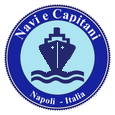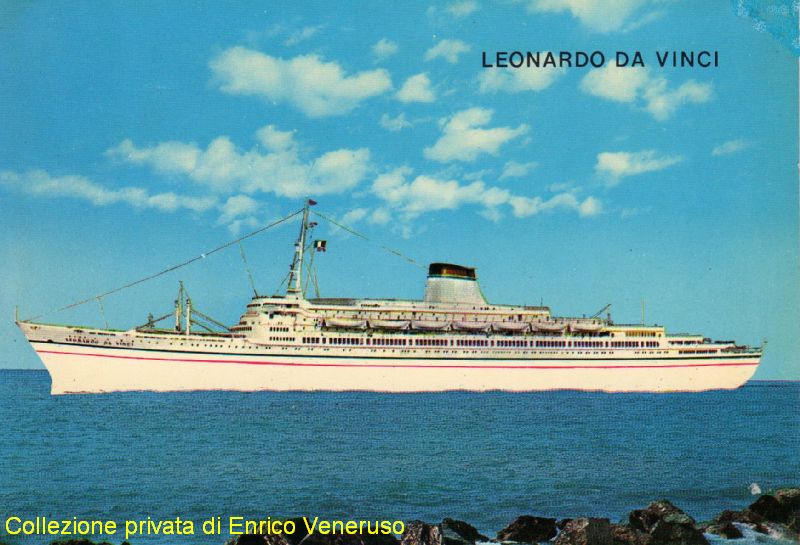 |

|
 |
 |
|
Nave da passggeri |  | |
| LEONARDO
DA VINCI |
| Bandiera | Flag | Italiana - Italian | |||
| Armatore | Owner | Società Italia di Navigazione - Trieste - ITALY | |||
| Varo | Launched | 07.12.1958 | |||
| Consegnata | Delivered | 30.06.1960 | |||
| Cantiere navale | Shipyard | Cantieri Navali Ansaldo - Genova - ITALY | |||
| Costruzione n. | Yard number | 1550 | |||
| Tipo di scafo | Hull type | scafo singolo - single hull | |||
| Materiale dello scafo | Hull material | acciaio - steel | |||
| Nominativo Internazionale | Call Sign | I
C L N - | |||
| I.M.O. Internationa Maritime Organization | 5206518 | ||||
| M.M.S.I. Maritime Mobile Service Identify | |||||
| Compartimento Marittimo | Port of Registry | Genova | |||
| Stazza Lorda | Gross Tonnage | 33.340 Tons | |||
| Stazza Netta | Net Tonnage | 17.227 Tons | |||
| Portata (estiva) | DWT (summer) | 5.641 Tonn | |||
| Lunghezza max | L.o.a. | 232,60 m | |||
| Lunghezza tra le Pp | L. between Pp | 205,80 m | |||
| Larghezza max | Breadth max | 28,60 m | |||
| Altezza di costruzione | Depth | ||||
| Pescaggio Max | Draugth max | 9,55 m | |||
| Bordo libero | Freeboard | ||||
| Motore principale | Main Engine | 4 - turbine/turbins Ansaldo | |||
| Potenza Motori | Engine Power | 38.792 Kw | |||
| Eliche di propulsione | Propellers | 2 - passo fisso / fixed pitch | |||
| Velocità massima | Max speed | 25,5 kn | |||
| Passeggeri | Passengers | 1.326 | |||
| Equipaggio | Crew | 538 | |||
| Navi gemelle | Sister ship | ||||
| Demolita | Scrapped |
06.05.1982 | |||
| Inserita il | Posted |
01.11.2008 | |||
| Aggiornata al | Last updated | 31.08.2011 | |||
| INFORMAZIONI
STORICHE La costruzione del translatlantico Leonardo da Vinci iniziò nel 1958 nei cantieri Ansaldo di Genova.Il varo avvenne il 7 dicembre 1958 e la nave fu battezzata dalla signora Carla Gronchi moglie dell'allora presidente della Repubblica Italiana. Nel luglio 1960 partì per il viaggio inaugurale da Genova per New York. Ben presto però ci si rese conto che la nave mostrava problemi di stabilità come la gemella " Andrea Doria " e pertanto fu necessario apportare delle modifiche per renderla più stabile ( furono aggiunte circa 3000 tonn di acciaio), questo comportò però un problema per i motori che non erano stati progettati per quell'aumento di peso, e per questo motivo la sua gestione in termini di consumi risultò la più alta della flotta. Purtroppo con l'aumento del trasporto aereo mantenere sulla linea passeggeri per l'america una nave del genere non era conveniente e venne trasformata in nave da crociera. Fu ridipinta di bianco e iniziò ad effettuare crociere tra i porti di : Palma, Messina, Palermo, Barcellona, Casablanca, Lisbona, Madeira, Las Palmas etc. IL 4 luglio 1980 fu portato a La Spezia e posto in disarmo . Durante la sosta inspiegabilmente s'incendio al punto da renderlo irrecuperabile.e nel 1982 fu avviato alla demolizione. Questa nave è ingiustamente spesso trascurata. Essa può essere considerata la madre della Michelangelo e Raffaello. Infatti conteneva per la prima volta una serie di innovazioni, mai presenti fino a quel momento sulle altre navi: cabine con servizi privati per tutte le classi, aria condizionata in tutta la nave, e dotata di due coppie di alette stabilizzatrici retraibili. Fu anche la prima nave passeggeri ad essere dotata di due sale macchine completamente indipendenti per ciascuna elica, come le navi da guerra. Le lance di salvataggio erano tutte dotate di motore e il meccanismo di discesa consentiva di calarle anche in caso di sbandamento laterale della nave fino a 25°. Queste ed altre caratteristiche architettoniche furono ulteriormente perfezionate ed adottate sulla Michelangelo e sulla Raffaello. La Leonardo da Vinci fu anche la prima nave passeggeri ad essere predisposta per la propulsione nucleare. Nel primo pomeriggio di giovedì 3 luglio 1980, in disarmo nel porto della Spezia la nave cominciò ad emettere denso fumo per un incendio a bordo. Presto giunsero rimorchiatori dotati di idranti. La nave fu trainata fuori dal porto e, a causa della gran quantità d'acqua proiettata attraverso oblò e finestroni, sbandò a sinistra adagiandosi su un basso fondale. Spento l'incendio fu raddrizzata e rimorchiata ai locali Cantieri Navali Lotti dove nel 1982/83 fu demolita. HISTORICAL INFO The construction of translatlantico Leonardo da Vinci began in 1958 in yards of Ansaldo Genova.Il launch took place on December 7 1958 and the ship was christened by his wife Carla Gronchi the President of the Italian Republic. In July 1960 left for the inaugural journey from Genoa to New York. But we soon realized that the ship showed stability issues such as the twin "Andrea Doria" and therefore it was necessary to make changes to make it more stable (about 3,000 were added tons of steel), but this caused a problem for engines that were not designed for quell'aumento weight, and why its management in terms of consumption was the highest of the fleet. Unfortunately, with the increase of air transport on the line to keep passengers on an American ship of its kind was not convenient and was transformed into a cruise ship. It was repainted in white and began to conduct cruises between ports: Palma, Messina, Palermo, Barcelona, Casablanca, Lisbon, Madeira, Las Palmas etc. ON 4 July 1980 was brought to La Spezia and placed in disarmament. During the stop inexplicably s'incendio as to make it irrecuperabile.e was launched in 1982 to demolition. This ship is often unfairly overlooked. It may be considered the mother of Michelangelo and Raphael. In fact contained for the first time a series of innovations, ever present until then on other ships: cabins with private facilities for all classes, air conditioning throughout the ship, and has two pairs of wings retractable Account. It was also the first passenger vessel to be equipped with two engine rooms completely independent of each helix, like warships. The rescue boats were all equipped with motor and mechanism of down calarle allowed in case of heel side of the ship up to 25 degrees. These and other architectural features were further refined and taken on Michelangelo and Raffaello. The Leonardo da Vinci was also the first passenger vessel to be prepared for nuclear propulsion. On thursday july 3rd 1980, in the first afternoon, the ship, being stripped, was moored in the port of La Spezia when a dark smoke revealed fire aboard. Soon two tugs equipped with fire-fighting pumps began to extinguish the fire. The L. Da Vinci was towed out the harbor but due to the great amount of water entered through windows and port-holes the ship listed on her port side laying on a shallow. Extinguished the fire aboard, the ship had been righted up and towed to the local shipyard Cantieri Navali Lotti where on 1982-83 was finally scrapped.
| |||||